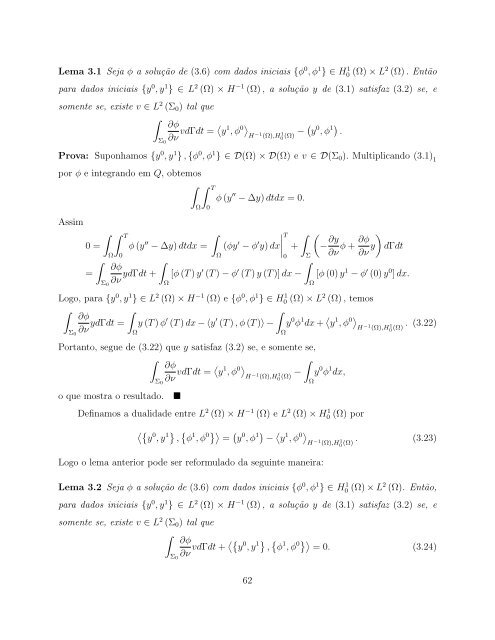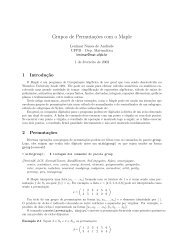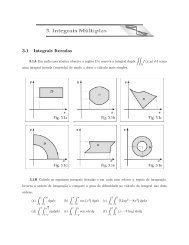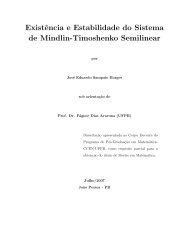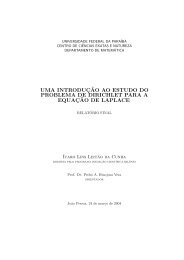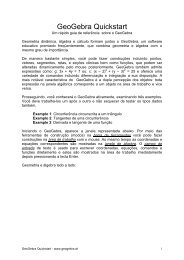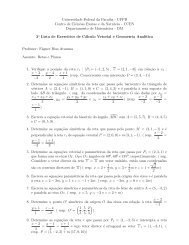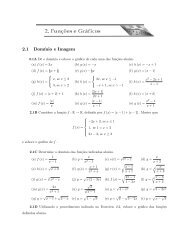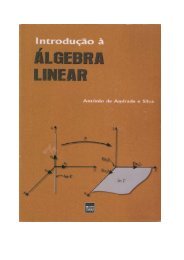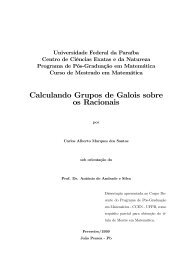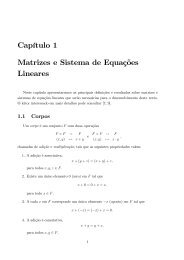Controlabilidade Exata e Aproximada da Equação da Onda Linear
Controlabilidade Exata e Aproximada da Equação da Onda Linear
Controlabilidade Exata e Aproximada da Equação da Onda Linear
Create successful ePaper yourself
Turn your PDF publications into a flip-book with our unique Google optimized e-Paper software.
Lema 3.1 Seja φ a solução de (3.6) com <strong>da</strong>dos iniciais {φ 0 , φ 1 } ∈ H 1 0 (Ω) × L 2 (Ω) . Então<br />
para <strong>da</strong>dos iniciais {y 0 , y 1 } ∈ L 2 (Ω) × H −1 (Ω) , a solução y de (3.1) satisfaz (3.2) se, e<br />
somente se, existe v ∈ L2 (Σ0) tal que<br />
<br />
∂φ<br />
Σ0<br />
∂ν vdΓdt = y 1 , φ 0<br />
H −1 (Ω),H 1 0 (Ω) − y 0 , φ 1 .<br />
Prova: Suponhamos {y 0 , y 1 } , {φ 0 , φ 1 } ∈ D(Ω) × D(Ω) e v ∈ D(Σ0). Multiplicando (3.1) 1<br />
por φ e integrando em Q, obtemos<br />
T<br />
φ (y ′′ − ∆y) dtdx = 0.<br />
Assim<br />
T<br />
0 = φ (y ′′ <br />
− ∆y) dtdx =<br />
<br />
=<br />
Σ0<br />
Ω<br />
0<br />
<br />
∂φ<br />
ydΓdt +<br />
∂ν<br />
Ω<br />
0<br />
<br />
<br />
(φy<br />
Ω<br />
′ − φ ′ T<br />
y) dx<br />
<br />
0<br />
[φ (T ) y<br />
Ω<br />
′ (T ) − φ ′ (T ) y (T )] dx −<br />
<br />
+ −<br />
Σ<br />
∂y ∂φ<br />
φ +<br />
∂ν ∂ν y<br />
<br />
dΓdt<br />
<br />
[φ (0) y<br />
Ω<br />
1 − φ ′ (0) y0 ] dx.<br />
Logo, para {y 0 , y 1 } ∈ L 2 (Ω) × H −1 (Ω) e {φ 0 , φ 1 } ∈ H 1 0 (Ω) × L 2 (Ω) , temos<br />
<br />
Σ0<br />
<br />
∂φ<br />
ydΓdt =<br />
∂ν<br />
y (T ) φ<br />
Ω<br />
′ (T ) dx − 〈y ′ (T ) , φ (T )〉 −<br />
Portanto, segue de (3.22) que y satisfaz (3.2) se, e somente se,<br />
<br />
∂φ<br />
<br />
Σ0<br />
o que mostra o resultado. <br />
∂ν vdΓdt = y 1 , φ 0<br />
H−1 (Ω),H1 −<br />
0 (Ω)<br />
<br />
Ω<br />
y 0 φ 1 dx + y 1 , φ 0<br />
H−1 (Ω),H1 . (3.22)<br />
0 (Ω)<br />
y<br />
Ω<br />
0 φ 1 dx,<br />
Definamos a duali<strong>da</strong>de entre L 2 (Ω) × H −1 (Ω) e L 2 (Ω) × H 1 0 (Ω) por<br />
0 1<br />
y , y , φ 1 , φ 0 = y 0 , φ 1 − y 1 , φ 0<br />
H−1 (Ω),H1 . (3.23)<br />
0 (Ω)<br />
Logo o lema anterior pode ser reformulado <strong>da</strong> seguinte maneira:<br />
Lema 3.2 Seja φ a solução de (3.6) com <strong>da</strong>dos iniciais {φ 0 , φ 1 } ∈ H 1 0 (Ω) × L 2 (Ω). Então,<br />
para <strong>da</strong>dos iniciais {y 0 , y 1 } ∈ L 2 (Ω) × H −1 (Ω) , a solução y de (3.1) satisfaz (3.2) se, e<br />
somente se, existe v ∈ L2 (Σ0) tal que<br />
<br />
∂φ<br />
∂ν vdΓdt + y 0 , y 1 , φ 1 , φ 0 = 0. (3.24)<br />
Σ0<br />
62


